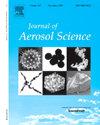Performance investigation of machine learning for optical modeling of black carbon aerosols with different coatings and humidities
IF 2.9
3区 环境科学与生态学
Q2 ENGINEERING, CHEMICAL
引用次数: 0
Abstract
Optical properties of black carbon (BC) aerosols are essential for assessing atmospheric radiation and climate change, but fast and accurate optical calculation for BC with complex structures is still a challenge. In this study, a quick optical modeling method for BC coated by different materials under various humidities is developed based on the multiple-sphere T-matrix (MSTM) simulation and support-vector-machine (SVM) algorithm. The typical closed-cell, coated-aggregate, and partially-coated BC models with BC monomers ranging from 50 to 2000 and BC volume fractions ranging from 0.05 to 0.70 are employed, and the relative errors (REs) and determination coefficients (R2) are used to investigate the prediction performance of optical properties based on SVM. Results show that the SVM predicted optical properties, such as optical efficiency, asymmetry factor, single scattering albedo, and lidar ratio, overall agree well with the properties simulated using MSTM. The prediction performance could be influenced by coating structure and morphological parameters, most of the values of REs and R2 were smaller than about 20 % and larger than about 0.85, respectively. The relative humidities (RHs) and coating materials slightly deteriorate the performance of SVM. With RHs increasing from 0 % to 95 %, or the coatings become non-absorbing organic carbon (OC) and brown carbon (BrC), the largest REs increase to over 30 %, while most of the R2 is still larger than 0.85. This study presented a promising optical modeling method for BC aerosols, and it could be further improved with the development of machine learning.
机器学习在不同涂层和湿度下黑碳气溶胶光学建模中的性能研究
黑碳气溶胶的光学性质是评估大气辐射和气候变化的基础,但对结构复杂的黑碳气溶胶进行快速准确的光学计算仍然是一个挑战。本研究基于多球t矩阵(MSTM)模拟和支持向量机(SVM)算法,提出了一种不同湿度下不同材料涂层BC的快速光学建模方法。采用BC单体为50 ~ 2000,BC体积分数为0.05 ~ 0.70的典型闭孔、包覆聚集体和部分包覆BC模型,利用相对误差(REs)和决定系数(R2)研究了基于SVM的光学性质预测性能。结果表明,SVM预测的光效率、不对称系数、单散射反照率和激光雷达比等光学特性与MSTM模拟的光学特性总体上吻合较好。预测性能受涂层结构和形态参数的影响,大部分REs和R2值分别小于约20%和大于约0.85。相对湿度(RHs)和涂层材料对支持向量机性能有轻微影响。随着RHs从0%增加到95%,或者涂层变成非吸收性有机碳(OC)和棕碳(BrC),最大的REs增加到30%以上,但大部分R2仍大于0.85。本研究提出了一种很有前途的BC气溶胶光学建模方法,并且可以随着机器学习的发展进一步改进。
本文章由计算机程序翻译,如有差异,请以英文原文为准。
求助全文
约1分钟内获得全文
求助全文
来源期刊

Journal of Aerosol Science
环境科学-工程:化工
CiteScore
8.80
自引率
8.90%
发文量
127
审稿时长
35 days
期刊介绍:
Founded in 1970, the Journal of Aerosol Science considers itself the prime vehicle for the publication of original work as well as reviews related to fundamental and applied aerosol research, as well as aerosol instrumentation. Its content is directed at scientists working in engineering disciplines, as well as physics, chemistry, and environmental sciences.
The editors welcome submissions of papers describing recent experimental, numerical, and theoretical research related to the following topics:
1. Fundamental Aerosol Science.
2. Applied Aerosol Science.
3. Instrumentation & Measurement Methods.
 求助内容:
求助内容: 应助结果提醒方式:
应助结果提醒方式:


